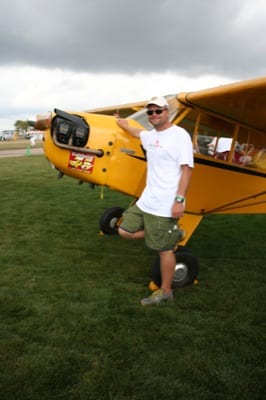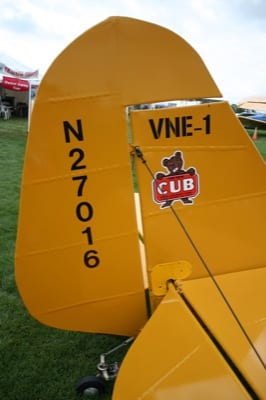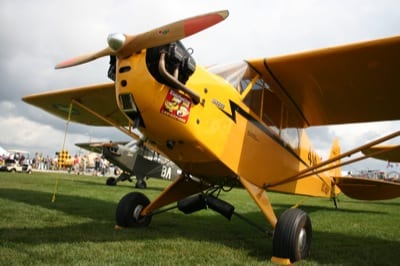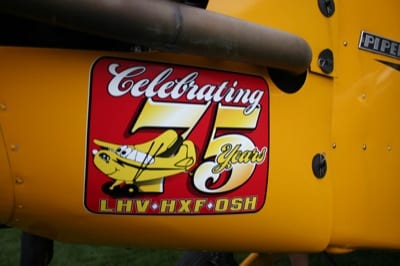The 75th anniversary of the Piper Cub was celebrated during AirVenture 2012. The vintage parking area looked like a field of buttercups for all the little yellow airplanes parked in the grass. But what was a J-3 Cub doing parked on the showcase pad in the Warbird area?
“That J-3 is an honest-to-goodness Warbird,” grinned Mike Porter from East Liverpool, Ohio.
 Porter is the proud owner of J-3 N2701. The FAA registration number appears vertically on the tail. Horizontally on the top of the vertical fin is the military designation VNE-1. The words U.S. Navy are emblazoned in block lettering on the side of the fuselage.
Porter is the proud owner of J-3 N2701. The FAA registration number appears vertically on the tail. Horizontally on the top of the vertical fin is the military designation VNE-1. The words U.S. Navy are emblazoned in block lettering on the side of the fuselage.
Porter was more than happy to explain how the docile J-3 earned its place in Warbird parking.
“During World War II the US Navy acquired about 230 J-3 Cubs,” he said. “Some were drafted, so to speak, others were acquired directly from the Piper factory and pressed into service. The Navy stenciled ‘US NAVY’ on the side and added a few stars and said ‘it’s now our airplane.’”
The Cubs were used as training aircraft and, in some instances, for surveillance along the coast. Porter’s Cub was in the latter category as it was assigned to an airship group.
“It was used for submarine patrol,” he said. “The Navy kept them in close to shore where they could be most effective.”
According to Porter, some Oshkosh visitors were surprised to learn of the J-3’s wartime service.
“That’s when I get to show them an old wartime photograph and training manual that shows the airplane in its markings,” he said. “From what I can tell, it was put back into civilian use in August of 1944.”
 etween its wartime service and Porter’s acquisition of the airplane in 1998, the Cub was modified to tow gliders. It was given a 150-hp Lycoming engine and a tow hitch.
etween its wartime service and Porter’s acquisition of the airplane in 1998, the Cub was modified to tow gliders. It was given a 150-hp Lycoming engine and a tow hitch.
Restoring it to its former glory was Richard Fenwick, who finished the project in 1992. “He restored the airplane back to its World War II livery, complete with US Navy identification markings and buzz numbers,” said Porter, who noted the restored Cub now has a 65-hp engine.
Porter is no stranger to tube and fabric Warbirds. He also owns a Stearman that was flown by the Women Airforce Service Pilots (WASP) during World War II in Sweetwater, Texas. (A story on Porter’s WASP Stearman was featured in the July 6, 2012, issue).
Other than a photograph and training manual, Porter doesn’t known much about his J-3 Cub.
“I don’t have anywhere near the documentation on it like I do the WASP Stearman,” he explained, noting that until the summer of 2012 the airplane didn’t roam too far from home because of the limited fuel capacity. Porter added a 12-gallon fuel tank to make the trip to Oshkosh. “The flight to Oshkosh took 14 hours and three fuel stops,” he said, noting the longest leg flown was a little over 10 hours.
As of yet, Porter hasn’t met anyone who flew this particular airplane during World War II, but he’s optimistic that it could happen someday.
“The plane flies between 150 and 175 hours a year and is on skis in the winter,” he noted. “I hope to be adding floats sometime in the next year.”
At AirVenture there was a decidedly unmilitary marking on the Cub: A cartoon applied to the airframe on a vinyl sticker depicting Porter’s trip to AirVenture by way of Lockhaven, Pa., the birthplace of Piper.
“I did the cartoon myself. I like to draw cartoon airplanes and I came up with this little cartoon Cub and created the logo and went over to a friend who does vinyl graphics and we printed it up and put it on the airplane,” he said.
 According to Porter, he had several requests for copies of the decal during the show.
According to Porter, he had several requests for copies of the decal during the show.
“A lot of people really liked it,” he said with a grin.

How about, any aircraft produced or applied toward the war effort from ww-I to the present? Lets be proud of our flying heritage no matter what the form or function. We are, after all a relatively small group. It’s just like getting guff about wearing a flight suit. What gives with that? I’m not trying to impersonate a military aviator. I don’t wear any insignia or patches I didn’t earn. It’s just darn comfortable as well as practical.
That’s the current definition. Sorry but I don’t consider an L-5 a “warbird” even though it was used during WWII as a liaison aircraft by US and British forces. The term “warbird” will always mean to me an aircraft designed for combat, not one the military repurposed for other uses. For instance the B-36 and B-47 bombers were designed for combat but to the best of my knowledge were never used in combat, but I would not be comfortable eliminating them from a list of “warbirds”. There have been many military aircraft produced between wars that were never in combat but I would never remove them from the warbird list simply because they were too obsolete to be used.
Sorry but just because an aircraft wore military markings does not make it a “warbird”
I understand Dennis’s conviction that a “warbird” should be described as an actual combat aircraft. And that troop support, recon, trainers, etc. should not be “lumped in” with this catagory. I guess a separate military catagory is in order.
The definition of warbird in my opinion is grossly over broad. Here is a simple definition that I use to exclude many so-called “warbirds”. A warbird is an aircraft that was designed from the outset as a combat aircraft. This of course excludes many surveillance, FAC, converted trainers, etc. Of course the reader can have their own opinion but they can expect to get a disgusted look from me when they call a T-6 Texan a “warbird”.